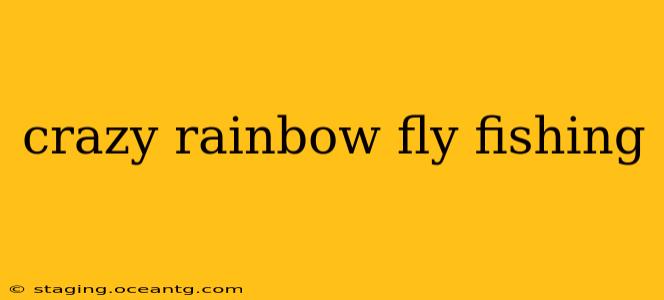Rainbow trout, with their vibrant hues and acrobatic leaps, are a favorite among fly fishers. But catching these elusive beauties isn't always easy. This guide delves into the exciting world of crazy rainbow fly fishing, exploring advanced techniques and tactics to help you land the trophy fish of your dreams. We'll cover everything from understanding their behavior to mastering the art of presentation. Get ready to experience the thrill of the chase like never before!
What Makes Rainbow Trout So Challenging to Catch?
Rainbow trout are known for their intelligence and discerning palates. Their feeding habits and environment greatly influence their behavior, making them a challenging opponent. Factors such as water temperature, flow, and the presence of other prey all impact their feeding patterns. Understanding these nuances is key to successful rainbow fly fishing.
Why are some rainbows more difficult to catch than others?
The difficulty in catching rainbow trout varies greatly depending on several factors. Size and age play a significant role; larger, older rainbows have encountered more fishing pressure and become more selective about their food. Their environment also matters. Rainbows in heavily fished waters are often more wary and harder to fool than those in less pressured environments. Finally, the time of year and water conditions can dramatically affect their feeding activity and willingness to strike.
How can I improve my chances of catching a rainbow trout?
Improving your chances of catching rainbow trout requires a combination of skill, knowledge, and patience. This involves thorough research of the specific water you’re fishing, mastering appropriate casting techniques for varying conditions, selecting the right flies, and understanding rainbow trout behavior. Learning to read the water—identifying feeding lanes, holding areas, and potential ambush points—is crucial.
Mastering the Art of Presentation: Fly Selection and Techniques
The key to successful rainbow trout fishing often lies in the presentation of your fly. This means not just choosing the right fly pattern but also mastering the casting techniques to deliver it naturally and convincingly.
What are the best flies for catching rainbow trout?
There is no single "best" fly for rainbow trout. The optimal fly depends heavily on the time of year, water conditions, and the specific insect life present in the river or lake. However, some highly effective patterns include:
- Adams: A classic dry fly that imitates various mayflies.
- Royal Wulff: A versatile dry fly effective in a range of conditions.
- Stimulator: A dry fly that imitates larger insects.
- Prince Nymph: A popular nymph pattern imitating various aquatic insects.
- Copper John: A versatile nymph effective in many situations.
Experimentation and observation are key to determining what works best in your chosen location.
What are some advanced casting techniques for rainbow trout?
Mastering various casting techniques is vital for success. Accurate casting is critical, allowing you to place your fly precisely in the desired area without spooking the fish. Techniques such as:
- Roll casting: Useful in tight spaces and close quarters.
- Curve casting: Effective for placing flies accurately upstream.
- Reach casting: Allows you to extend your casting range.
Practicing these techniques will significantly improve your accuracy and effectiveness.
Understanding Rainbow Trout Behavior and Habitat
Observing and understanding rainbow trout behavior and their preferred habitats is crucial to successful fishing.
Where do rainbow trout live?
Rainbow trout thrive in a variety of habitats, from cold, clear streams and rivers to lakes and reservoirs. They prefer clean, well-oxygenated water with ample cover, such as submerged rocks, logs, and overhanging vegetation.
What time of year is best for catching rainbow trout?
Rainbow trout fishing can be successful throughout the year, but peak activity often occurs during spring and fall when water temperatures are moderate. Summer can be challenging due to higher water temperatures, while winter fishing can be productive but requires specialized techniques and gear.
What are some effective strategies for catching rainbow trout in different water conditions?
Adapting your techniques to changing water conditions is crucial. In fast-flowing water, focus on using weighted nymphs and smaller flies. In slower water, dry flies and larger nymphs can be more effective. In clear water, subtle presentations are key, while in murky water, more vibrant and larger flies may be necessary.
By mastering these techniques and understanding the intricacies of rainbow trout behavior, you'll significantly increase your chances of experiencing the thrill of landing that prized rainbow. Remember, patience, persistence, and a keen eye for detail are essential ingredients to success in the exciting world of crazy rainbow fly fishing.
